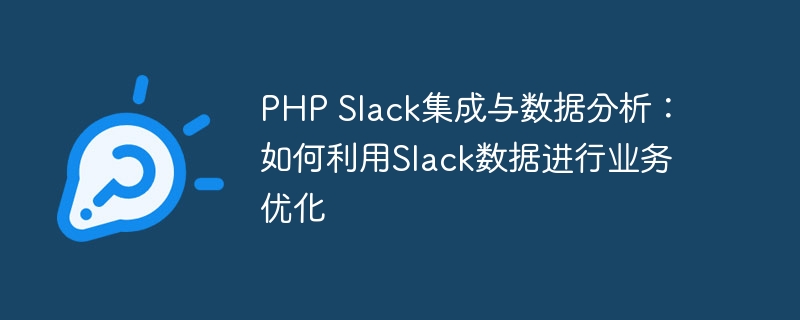

PHP Slack Integration and Data Analysis: How to Use Slack Data for Business Optimization
Introduction:
In today's digital era, data has become an important part of corporate decision-making and business key factors for optimization. As a popular enterprise communication tool, Slack can not only help teams work together, but also provide rich data to provide strong support for enterprise business optimization. This article will introduce how to use PHP for Slack integration and use Slack data for business optimization, while providing specific code examples.
1. Slack integration
composer require slack/php-api
$clientId = 'your_client_id';
$clientSecret = 'your_client_secret';
$redirectUri = 'http://your-redirect-uri.com';
$oauthUrl = "https://slack.com/oauth/v2/authorize?client_id={$clientId}&redirect_uri={$redirectUri}&scope=channels:history";
header("Location: {$oauthUrl}");In the above code, we are redirecting the user to the Slack authorization page. Once the user authorizes, Slack will redirect the user to the redirect URI you provided, passing the authorization code in the URL parameters.
$clientId = 'your_client_id';
$clientSecret = 'your_client_secret';
$redirectUri = 'http://your-redirect-uri.com';
$code = $_GET['code'];
$oauthUrl = "https://slack.com/api/oauth.v2.access?client_id={$clientId}&client_secret={$clientSecret}&code={$code}&redirect_uri={$redirectUri}";
$response = file_get_contents($oauthUrl);
$data = json_decode($response, true);
$accessToken = $data['access_token'];In the above code, we exchange the access token with the authorization code and extract the token from the response.
$apiUrl = 'https://slack.com/api/conversations.list';
$token = 'your_access_token';
$options = [
'headers' => [
'Authorization: Bearer {$token}',
],
];
$response = file_get_contents($apiUrl, false, stream_context_create($options));
$data = json_decode($response, true);
// 处理获取的频道列表数据In the above code, we authenticate using the access token and extract the channel list data from the response.
2. Data Analysis and Business Optimization
$apiUrl = 'https://slack.com/api/conversations.history';
$token = 'your_access_token';
$channelId = 'your_channel_id';
$options = [
'headers' => [
'Authorization: Bearer {$token}',
],
];
$queryParams = [
'channel' => $channelId,
];
$apiUrl .= '?' . http_build_query($queryParams);
$response = file_get_contents($apiUrl, false, stream_context_create($options));
$data = json_decode($response, true);
$messageCount = count($data['messages']);In the above code, we count the number of messages in the channel and store it in the $messageCount variable.
$apiUrl = 'https://slack.com/api/chat.postMessage';
$token = 'your_access_token';
$channelId = 'your_channel_id';
$options = [
'http' => [
'header' => 'Content-type: application/json
',
'method' => 'POST',
'content' => json_encode([
'channel' => $channelId,
'text' => 'New message in the channel!',
]),
],
];
$apiUrl .= '?token=' . $token;
$context = stream_context_create($options);
$response = file_get_contents($apiUrl, false, $context);In the above code, we use Slack’s chat.postMessage API to send a message to a specific channel.
Conclusion:
Through PHP Slack integration, we can easily obtain and analyze Slack data and use this data for business optimization. Whether it is statistical analysis or event reminders, Slack provides a rich API to meet our needs. Using the specific code examples provided above, you can start using Slack data to improve your business processes and decisions.
The above is the detailed content of PHP Slack integration and data analysis: How to use Slack data for business optimization. For more information, please follow other related articles on the PHP Chinese website!